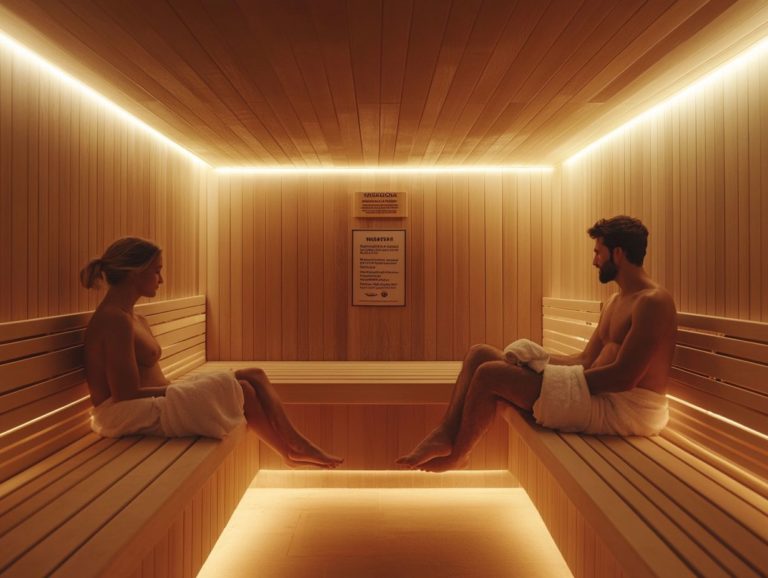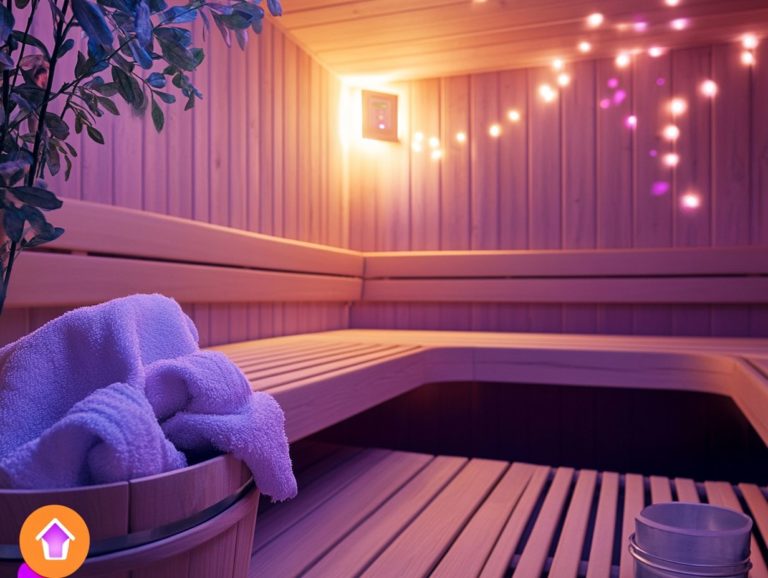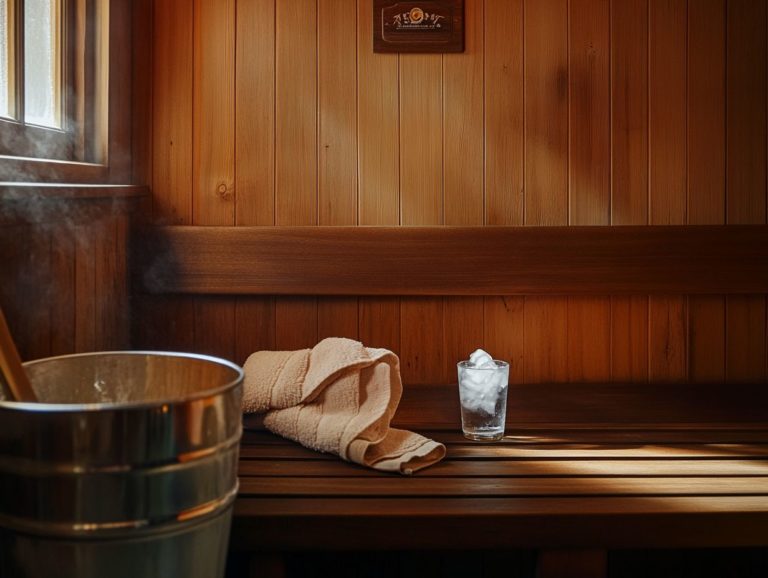Sauna Safety: Building Awareness in Communities
Saunas are well-known for their many health benefits. These benefits include better circulation and deep relaxation. To enjoy these benefits, it’s important to understand sauna safety.
This article covers essential safety practices for sauna use. It highlights risks and precautions for all age groups. Proper installation and maintenance of the sauna heater are crucial, as well as dispelling common misconceptions.
By understanding and promoting sauna culture, you can help create safer sauna experiences for everyone. Explore the insights provided to enjoy this age-old tradition responsibly and fully.
Contents
- Key Takeaways:
- The Benefits of Sauna Use
- Understanding Sauna Safety
- Sauna Safety for Different Age Groups
- Ensuring Safe Sauna Practices
- Common Misconceptions about Sauna Safety
- Promoting Sauna Safety in Communities
- Frequently Asked Questions
- What are the potential dangers of using a sauna?
- How can I ensure the safety of my community members when using a sauna?
- What precautions should I take before using a sauna?
- Are there any age restrictions for sauna use?
- What should I do if I experience discomfort or lightheadedness in the sauna?
- Can using a sauna lead to any long-term health issues?
Key Takeaways:

- Regular sauna use offers many physical and mental health benefits. Be aware of potential risks and take precautions to ensure safety.
- Different age groups require specific guidelines for sauna use. Extra caution is needed for children and seniors.
- Safe sauna practices involve proper installation and maintenance of sauna products. Educate communities by promoting accurate information through initiatives and resources.
The Benefits of Sauna Use
Incorporating sauna sessions into your wellness routine can yield a wealth of health benefits. Saunas are popular in fitness centers throughout North America, Finland, and Sweden, especially in places like the YMCA.
Research shows that regular sauna use can enhance heart health, foster social connections within the vibrant sauna culture, and play a vital role in community wellness initiatives, such as Polar Bear Club gatherings.
Whether you choose a traditional sauna or a state-of-the-art infrared sauna a type that uses light to heat the body directly you ll find that the experience melds heat therapy with social interaction. This combination creates a distinctive health retreat appealing to individuals and groups.
Physical and Mental Health Benefits
Engaging in regular sauna sessions offers remarkable benefits for both your physical and mental health. This makes a strong case for including saunas in your wellness routine, especially when combined with cold water therapy or cold plunge techniques.
The heat exposure in a sauna alleviates stress and anxiety, contributing to improved mental clarity and emotional balance. This is particularly true when combined with cold immersion practices.
Frequent sauna use can strengthen your heart by improving circulation and lowering blood pressure. This allows your heart to pump blood more efficiently. The heat also aids in muscle recovery by boosting blood flow to sore muscles, significantly reducing recovery time after workouts.
On the mental health front, many individuals report an uplifted mood and better sleep quality following their sauna sessions. This is especially true when they incorporate cold therapy after heat sessions.
Complementing these benefits with cold therapy like cold showers, ice baths, or even cold plunge practices can elevate your recovery even further. This refreshing contrast invigorates your body and leads to an optimized wellness regimen that nurtures both body and mind.
Understanding Sauna Safety
Understanding sauna safety is crucial for fully enjoying the health benefits while minimizing risks from improper practices. These include electrical malfunctions and sauna fires.
By ensuring that the sauna is well-maintained and conducting sauna inspections, you can significantly enhance the safety of your sauna sessions. Implementing a robust emergency action plan helps address issues like minor smoke inhalation.
This proactive approach prevents issues such as minor smoke inhalation, electrical malfunctions, and potential property damage from sauna fires. This allows you to relax with peace of mind.
Potential Risks and Precautions
While sauna use offers numerous health benefits, it s essential to recognize potential risks, such as minor smoke inhalation and electrical malfunctions that could lead to sauna fires. Developing a detailed safety plan is critical for effectively addressing these concerns.
Be mindful of the dangers posed by dehydration and overheating, which can arise from spending too much time in the heat or not drinking enough water during sauna usage. To combat these issues, consider setting timers to stick to recommended session lengths, typically around 15 to 20 minutes.
Regularly inspect sauna equipment, especially the sauna heater, for safe usage. By checking for signs of wear and ensuring safety mechanisms are functioning properly, such as a reliable sprinkler system, you can significantly lower the risk of equipment malfunctions. For more insights, consider exploring sauna safety and self-reflection.
Sauna Safety for Different Age Groups

Sauna safety practices can differ greatly among various age groups. It s crucial to customize guidelines for both children and seniors to guarantee a safe and enjoyable experience.
Always supervise children during sauna sessions to ensure their safety and comfort, particularly given their lower heat tolerance. For seniors, additional precautions may be necessary due to age-related health considerations. This highlights the importance of open communication about sauna safety, contributing to a more enjoyable sauna experience for everyone.
Guidelines for Children and Seniors
When introducing children and seniors to sauna use, it s essential to establish clear guidelines that prioritize safety while maximizing health benefits. Recognize that children generally have a lower heat tolerance, which calls for shorter sauna sessions.
For children, keep their sessions to a brief 5-10 minutes under vigilant adult supervision to monitor their comfort and hydration. Set the sauna to a mild temperature to avoid overheating and promote well-being.
Seniors can begin with sessions lasting 10-15 minutes, slowly increasing the duration as they adjust to the heat. It’s wise for seniors to consult healthcare professionals beforehand, especially if they have chronic health concerns related to sauna usage.
Both groups can enjoy enhanced circulation and relaxation, making sauna use a beneficial part of their routine when approached thoughtfully and with care.
Ensuring Safe Sauna Practices
Ensuring safe sauna practices is essential for maximizing health benefits while minimizing associated risks. Proper installation and diligent maintenance of saunas are crucial. Incorporate features like a reliable sprinkler system and routine inspections to address potential hazards effectively.
By prioritizing these elements, you create a safe and enjoyable environment that enhances the overall sauna experience.
Proper Installation and Maintenance
Proper installation and ongoing maintenance of your sauna are crucial for safety and maximizing the benefits of heat therapy. This means setting up sauna heaters correctly and ensuring the wood is adequately dried.
When you install a sauna heater with care, you optimize energy efficiency and create a safer environment, reducing risks like overheating and fire hazards. Choosing the right type of wood, such as cedar or spruce, enhances aesthetic appeal and ensures durability and moisture resistance, key for your sauna’s longevity.
Regularly check the sauna heater’s functionality and the condition of the wood to allow for early detection of potential problems. Ensure proper ventilation to maintain air quality, while routine cleaning prevents the accumulation of harmful substances. By adopting these best practices, you can learn from sauna safety personal experiences to ensure a safe, enjoyable, and effective heat therapy experience.
Common Misconceptions about Sauna Safety
It’s important to address common misconceptions about sauna safety. This helps everyone understand its benefits better, especially regarding sauna usage. Some people wrongly believe that using a sauna is dangerous, overlooking the many health benefits it provides and the education programs surrounding it. Additionally, the sense of community that comes from the shared sauna experience is invaluable.
Dispelling Myths and Providing Accurate Information

Dispelling myths about sauna use is essential. It promotes health benefits and creates a safe environment for users. This helps facilitate community wellness through informed practices. Many misconceptions can foster fear and hesitation, keeping you from enjoying sauna culture and reaping its numerous community wellness advantages, including the benefits of participating in group experiences.
One common myth suggests that sauna-goers face significant risks of dehydration, which can make you shy away from this revitalizing practice. However, research shows that while sweating does happen, your body is well-equipped to manage fluid levels. This is especially true if you use water to help your body stay hydrated before and after your sauna sessions.
Concerns about safety often arise, with some believing that saunas aren’t suitable for certain populations, including those with chronic health issues. In truth, most people can safely enjoy the benefits of sauna use. However, it’s wise to consult a healthcare provider if you have specific medical conditions related to sauna usage. For more information on this topic, check out our guide on sauna safety.
Understanding these facts can empower you to engage in sauna activities with confidence and peace of mind, especially when considering sauna safety. This will enhance your personal experience.
Promoting Sauna Safety in Communities
Promoting sauna safety within your community is vital. It encourages responsible usage and enriches the overall wellness routines of residents. By implementing education programs, you can raise awareness about safe sauna practices. This seamlessly integrates wellness into daily habits and cultivates community gatherings that celebrate sauna culture.
Organizations like the Polar Bear Club show how to foster community and shared wellness. They create a vibrant culture around sauna safety and enjoyment.
Educational Initiatives and Resources
Implementing education programs focused on sauna safety can significantly elevate your community’s awareness and participation. This leads to a more fulfilling experience of health benefits. Consider programs that encompass workshops, informative resources, and collaborative wellness routines that prioritize sauna safety.
By tapping into local expertise and actively engaging community members, these initiatives share essential information and cultivate a sense of ownership in promoting safe practices. For example, community organizations might offer regular training sessions to educate participants on proper sauna usage. They can provide guidelines on temperature settings and emphasize the importance of hydration. Additionally, understanding sauna safety is crucial for a safe and enjoyable experience.
Successful programs, like those led by health departments in various regions, often feature interactive demonstrations and Q&A sessions. These effectively break down barriers to knowledge and foster a communal approach to wellness. This culture of health and safety can lead to increased participation in sauna activities, reflecting a collective commitment to well-being. For those looking to enhance their sauna experience, understanding sauna safety in social situations is essential.
Frequently Asked Questions
Here are some common questions people ask about sauna safety.
What are the potential dangers of using a sauna?
Using a sauna can cause dehydration, overheating, and dizziness. It can also aggravate pre-existing medical conditions such as heart disease or respiratory issues.
How can I ensure the safety of my community members when using a sauna?

Properly educating individuals on sauna safety, providing clear guidelines and rules, and regularly maintaining and updating sauna equipment are all important steps in ensuring community safety.
What precautions should I take before using a sauna?
Before entering a sauna, make sure you are well-hydrated. Avoid alcohol and heavy meals.
Keep your sauna sessions to 15 minutes or less for a safe and refreshing experience!
Are there any age restrictions for sauna use?
Children under 12 should not use saunas. Those aged 12-16 need adult supervision.
People over 65 should talk to their doctor before using a sauna.
What should I do if I experience discomfort or lightheadedness in the sauna?
If you feel dizzy or uncomfortable, leave the sauna immediately to cool down. Drink water and adjust the temperature to feel better.
Can using a sauna lead to any long-term health issues?
Using a sauna in moderation and following safety guidelines is generally safe. People with existing health issues should talk to their doctor before using the sauna regularly.






